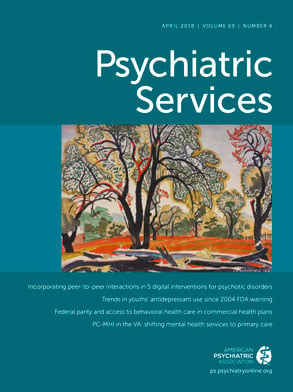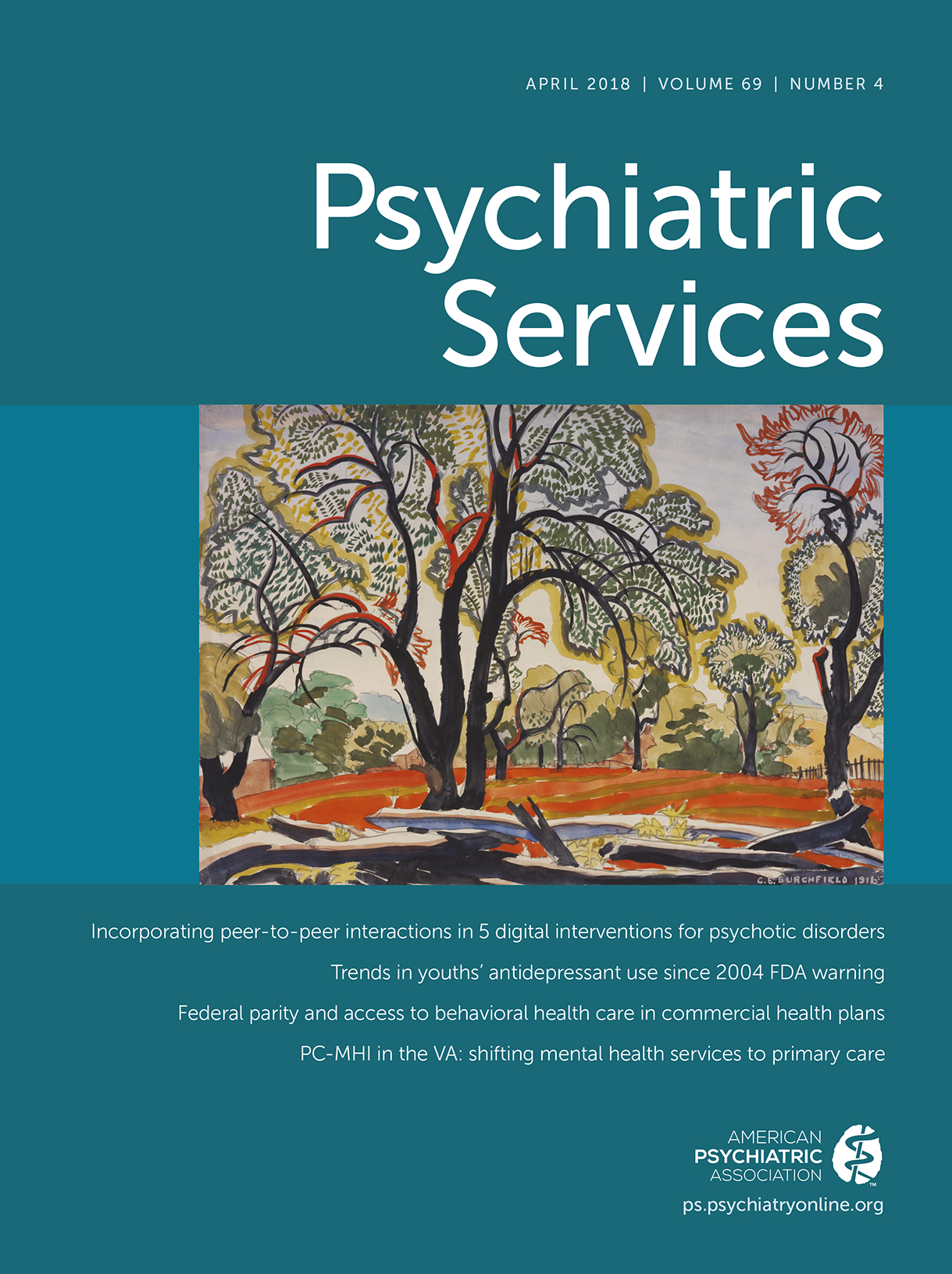Depression and other behavioral health issues are prevalent among patients with complex medical conditions and often go unrecognized and untreated in primary or acute care settings (
1). Lack of treatment is associated with poorer outcomes and increased health care costs (
2). Even when patients are recognized to have behavioral health issues, there is a dearth of high-quality, consistently delivered, and easily accessible behavioral health service options (
3). Moreover, individuals with coexisting behavioral and general medical challenges may have difficulties with psychotherapy initiation and adherence (
4).
As such, innovative solutions are needed to optimize patient identification and access to care, to deliver high-quality behavioral health care with consistent application of evidence-based best practices, and to sustain patient engagement. A creative combination of data analytics, technology, and interpersonal care delivery via telehealth may bridge these gaps.
Trials have demonstrated that telehealth interventions, such as psychotherapy delivered by telephone or video, are effective and comparable in efficacy to face-to-face treatment of depression (
5,
6). Advantages of remotely delivered therapy include reduced geographic, physical, or time-related constraints for patients, potential cost savings to the health care system, and enhanced opportunities for collaborative care (
7). In this column we describe a novel behavioral health solution designed to identify, engage, and treat patients with behavioral health comorbidities.
The Model
AbleTo is a national technology-enabled behavioral health care provider that delivers proactive evidence-based and quality-assured behavioral therapy programs to individuals living with comorbid general medical and behavioral health conditions or experiencing life challenges. All care is delivered remotely by phone or secure video and supported by digital tools. [A figure in the online supplement illustrates the process.]
Participants.
Potential participants are identified by outbound engagement via telephone or by direct inbound referral from community or health plan providers, including care management teams. Targeted outreach is guided by clinical algorithms applied to medical and pharmacy claims and other data sources to identify individuals with higher risk of behavioral health issues, high resource utilization, and high-risk medical comorbidities. Trained engagement specialists perform outreach. Clinically appropriate, interested individuals are registered after completing privacy and safety procedures (including HIPAA practices). Participants are required to be ≥18 years old and to have access to a telephone.
Providers.
All care is delivered by AbleTo’s national network of recruited, trained, and supervised therapists (licensed clinical social workers [LCSWs] or state-recognized equivalent positions) and behavior coaches. Therapists are required to be experienced in cognitive-behavioral therapy, adept at telehealth care delivery, and knowledgeable about the care of high-risk populations with general medical conditions and behavioral health issues or who are navigating life transitions. Behavior coaches are master’s-level clinicians, with a degree in psychology, nursing, or a related field, and have at least two years of clinical behavioral health experience. All clinicians are formally trained to deliver AbleTo’s evidence-based programs and are supervised by senior clinicians (LCSWs with prior experience supervising evidence-based psychotherapy) who perform case note review, hold case conferences for each patient, provide emergency consultation, and direct care coordination.
Initial consultation.
Initial consultation with a therapist is completed via telephone and includes a full behavioral health clinical evaluation and risk assessment, including assignment of a provisional DSM-5 diagnosis. Individuals are ineligible for the program if their clinical presentations are deemed to be too risky and if in-person community-based resources are determined to be more clinically appropriate. To ensure the safety of the patient and others at risk, the intervention uses strict emergency protocols to manage acute or imminent suicide risk and symptoms of severe mental illness. Patients ineligible for the intervention are referred to a community provider by following a standardized protocol.
Program overview.
The program consists of the initial consultation followed by 15 modular sessions delivered over approximately eight weeks that alternate between psychotherapy sessions and behavioral coaching. Each participant is assigned to a program protocol matched to his or her specific health conditions, including behavioral health conditions (such as postpartum depression, anxiety with or without panic attacks, depression, and substance misuse), self-reported life challenges (such as bereavement and caregiving), and acute and chronic medical conditions with which comorbid behavioral health issues are highly prevalent (including diabetes, cardiovascular disease, chronic pain, cancer, gastrointestinal conditions, and respiratory conditions). The assigned program protocol is selected on the basis of the participant’s chief complaints and primary concerns, general medical and psychiatric diagnoses, symptom presentation, and the therapist’s assessment and recommendation at initial consultation. Treatment modules are based on empirical research integrating standard and third-wave cognitive-behavioral therapy models. Session content is standardized and focused on identified areas for behavior change, but each participant’s experience is personalized to identify and address barriers and specific goals. Coordination of care with the participant’s providers occurs throughout the engagement and treatment and is a standard component of discharge.
Cost.
AbleTo partners with health plans, self-insured employers, and provider organizations to provide behavioral health services as an in-network benefit. Participants have modest to no out-of-pocket cost depending on their health plan benefits and associated copayments or deductibles.
Quality Assurance
Consistent delivery of high-quality care is facilitated in multiple ways. First, providers are required to have extensive didactic and practical training, demonstrated experience, and additional training specific to the AbleTo program, HIPAA, privacy and data security, and best practices for telehealth care delivery [see online supplement]. Providers are evaluated regularly by a clinical supervisor. Second, the program is delivered via a customized technology platform that provides clinicians access to standardized session protocols. The platform serves as a protected electronic record for session notes and supports secure electronic communication among the clinical team and with participants. Third, the intervention includes standardized collection of patient-reported outcomes and progress completing behavioral goals. Therapists participate in case conferences with a clinical supervisor to discuss case conceptualization, treatment planning and progress, safety, discharge planning, and protocol adherence.
Evaluation
We conducted a retrospective evaluation of AbleTo’s program reach and experience by using a deidentified clinical data set from a sample of 1,482 consecutive program graduates with elevated pretreatment DASS-21 scores and who completed the program between January 1, 2014, and June 30, 2015 (
8) [see flow diagram in
online supplement]. Participant demographic characteristics, general medical and psychiatric history, and medication use were systematically collected. Program satisfaction was assessed posttreatment on a scale (scores range from 0 to 8) adapted from the Net Promoter Score (
9). This research was approved by the Sterling Institutional Review Board.
The program had national reach in the United States, spanning the Northeast, Southeast, Midwest, and West nondifferentially [see table in online supplement]. Participants were predominantly female (64%, N=952) with an average age of 53.7±9.5 years. Common comorbid medical conditions included hypertension and diabetes. Almost one in three (29%, N=300 of 1,023) participants presenting with elevated depressive symptoms did not report a history of diagnosed depression, and close to half (43%, N=458 of 1,072) with elevated anxiety symptoms did not report a prior diagnosis of anxiety.
Median DASS-21 depression scores decreased pre- to posttreatment, from 18 (interquartile range [IQR] 12–24) to 6 points (IQR 2–12), among participants with elevated baseline depression scale scores (69%, N=1,023). The median within-person decrease from pretreatment to posttreatment of 10 points (IQR –6 to –16) was significant (Wilcoxon signed-rank test; p<.001), with a large effect size (r=–.53). Overall, 64% (N=658) of patients exhibited symptom reduction (≥50% score reduction), and 45% (N=459) completed the program with ≥70% score reduction. Similar clinically meaningful, statistically significant changes were observed in anxiety and stress scores [see graph in online supplement].
In a stratified analysis using Wilcoxon rank-sum two-sample tests to determine whether changes in DASS-21 scores differed among those who started an antidepressant during the treatment period (N=100), no significant differences were observed. Median changes in depression, anxiety, and stress scores were similar among those who initiated antidepressant therapy and those who did not.
At graduation, more than 95% (N=1,408) of participants completed the program satisfaction assessment. Among them, 98% (N=1,379) rated their satisfaction as 6 or higher, with 84% (N=1,187) rating their satisfaction as 8 out of 8 (highest rating).
Discussion
We have described an innovative telehealth model that addresses three nationally recognized barriers to behavioral health care: patient identification and proactive engagement, access to care, and quality-assured delivery of best-practice care. The model was designed to identify individuals at a time of increased risk for psychological comorbidity and to provide outreach to coordinate enrollment into a remotely delivered standardized therapy program tailored to meet individual clinical needs. We demonstrated wide reach of the program and identification of symptomatic participants who did not report a history of diagnosed depression or anxiety in their lifetime. Program satisfaction was high, and participants experienced significant reduction in depression, anxiety, and stress symptoms during the program period. Symptom reductions were observed among participants irrespective of whether antidepressants were initiated during treatment.
The approach we describe expands the current evidence regarding behavioral telehealth programs in several ways, including data-driven methodology applied in partnership with health plans and providers to identify individuals who may be in need of behavioral health care; proactive outreach to identified individuals to screen for behavioral health conditions, including high-risk symptoms, and facilitate access and enrollment; national reach of the quality-assured evidence-based program; and program standardization with modular design to meet individual treatment and care coordination needs of the participant.
The modular nature of the program allows for dynamic adjustment to patient and clinician needs while retaining an evidence-based protocol. The program also includes protocols to meet the needs of diverse patient populations who may benefit from behavioral therapy. This tailored and inclusive approach represents translation of telehealth research into scaled clinical practice and diverges from published telehealth evaluations that, by design, are limited to strict inclusion of homogeneous samples.
The program evaluation documented scalability of a high-quality technology-enabled program with the potential to reach many patients otherwise unable to receive traditional mental health care services. This model focuses on the treatment of behavioral health symptoms as a means to improve adherence to general medical treatment and overall physical health outcomes and reduce total cost of care (
10,
11). Thus, if proven to be effective, an innovative behavioral health care model of this nature stands to benefit a variety of health care stakeholders, from patients to employers and payers.
There are limitations to the inferences that can be drawn from the evaluation data. First, the lack of a control group precludes formal determination of causality. But data from other telehealth intervention trials support the consistency and feasibility of findings (
5,
6). Second, midtreatment and longer-term follow-up data are not yet available to evaluate treatment “dose” versus response and longevity of symptom decreases. However, follow-up studies of this program have demonstrated improvement in medical outcomes and reduction in medical utilization (
11). Third, the program evaluation data presented herein are for commercially insured adults; it is unknown whether these results generalize to other populations. A strength of the data is the large patient sample, representative of “real world” telehealth care seekers.
Conclusions
Behavioral health conditions are prevalent among patients with medical comorbidities and often go unrecognized or untreated because of barriers, including inadequate identification of patients in need and insufficient access to high-quality behavioral health care. We have described a nationally scaled telehealth model designed to overcome barriers to identification and enrollment into therapy. Participants were highly satisfied and experienced clinically meaningful improvements in behavioral health outcomes, further underscoring the potential impact that a telehealth solution could have in optimizing treatment outcomes.

